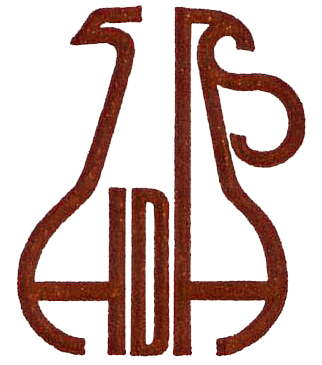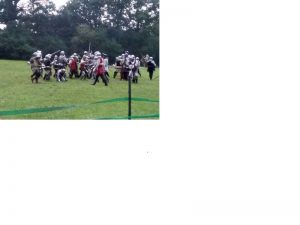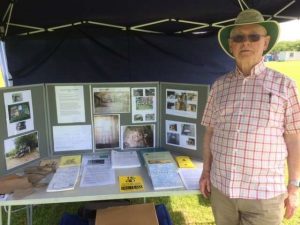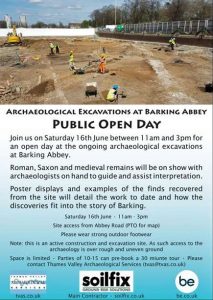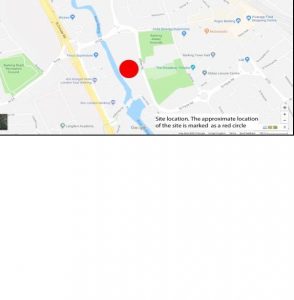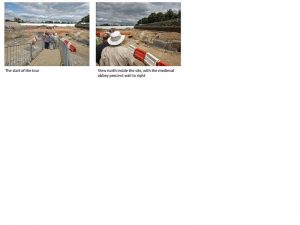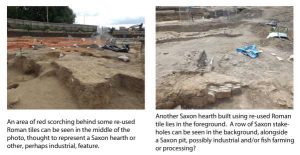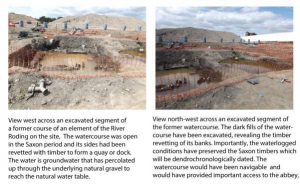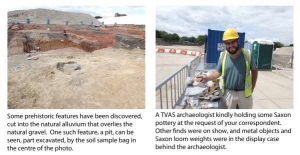Newsletter-128-October-1981
|
Newsletter 128: October, 1981 HADAS CALENDAR DON’T FORGET LECTURES START THIS MONTH Weatherwise there seems little difference this year between summer and winter, so we will just say the lecture season has arrived. This year we have considerable variety, including a 3-part London series – Roman, Saxo-Norman and post-medieval. Tuesday, October 6th. The Roman Port of London – the current excavation in the Pudding Lane area of the City. Speaker Gustav Milne, the site supervisor, who will give us a first-hand and up-to-date report on the Roman water front. Tuesday, November 3rd. Excavations on Guernsey 1979-81, Dr Ian Kinnes MA PhD FSA. Tuesday, December 8th. Dinner at the RAF Museum, Hendon, with private viewing of the Battle of Britain exhibition. Tuesday, January 5th .Saxon and Norman London, Dr John Clark MA AMA FSA.
Tuesday, February 2nd. Marylebone: A Village Community 1500-1800. Dr Ann Saunders PhD. Tuesday, March 2nd. Frozen Tombs of Siberia, Kenneth Whitehorn.
As usual lectures will be at Central Library, next to Hendon Town Hall, on the first Tuesday of each month, excluding December. We start soon after 8 pm, with coffee and biscuits (price 10p) which gives members an opportunity for a chat. May I ask old members to welcome new ones and make them feel at home? For Our first two lectures, David Bicknell will be our projectionist – Liz Holliday regrets she has an evening class on Tuesdays this year. For new members buses 183 and 143 pass the Library door. It is 10 minutes walk from Hendon Central station and only a few minutes from the 113 Edgware route or the 240 and 125 routes. There are two free car parks opposite. Members may bring a guest to one lecture, but guests who wish to attend further lectures should be invited to join the Society. DOROTHY NEWBURY
SUBSCRIPTIONS The Hon. Treasurer has been doing his autumn review of the membership records and finds there are.136 members who have still not renewed their membership for 1981/2, although this was due on April 1, 1931. To save him writing reminder letters, please send any outstanding subscriptions to him as soon as possible. His address is: Jeremy Clynes, 66 Hampstead Way, London NW11 7XX (Tel: 455 4271).
THE, OUTING SEASON … ends as we go to press, with a re-run on Sept 20 to Bath and Laycock. It will be another full coach. In spite of our bad summer all trips have enjoyed dry weather. Again I have been unable to accompany the groups, and would like to thank George Ingram, Tessa Smith, Paul Craddock, Maurice Canter, Ted Sammes and Jeremy Clynes for taking the trips so successfully for me. DOROTHY NEWBURY
PRAYER FOR A TYPIST Your Newsletter comes to you each month by favour of a number of your fellow members who volunteer to Write, edit and type it, roll off the stencils, prepare the envelopes and fill, post or deliver them. From time to time there are hiccups in each of these departments. At the moment we are short of Newsletter typists. Some of our editors type’their own Newsletters; but one or two, who do not possess typing skill, need to call on a typist volunteer. We have two exceedingly helpful and willing typists, but we would like to find at least two more – that way we could spread the load and have a reserve when one of our “regulars” can’t do the job. Could you type an occasional Newsletter for us? It would not be more often than once in 6 months, and if we had several volunteers the interval could be longer. You need, either to have a typewriter heavy enough to cut stencils; or to be prepared to spend the necessary time cutting the stencils (a job which presents no difficulty to any experienced typist) on one of the Society’s two machines’ (one electric, one manual) at our room in Avenue House, East End Road, Finchley. All offers will be most gratefully received by our Hon. Secretary. Please ring if you can help.
CONGRATULATIONS to HADAS member Wendy Page, now Wendy Cones, on the birth of her first baby – Anthony. Wendy is now living at Woodbridge, in Suffolk.
TWO MORE BUILDINGS PROTECTED As the Newsletter goes to press there comes news that two further buildings in the Borough. of Barnet have been added to the List of Buildings of Architectural and Historic Interest. Both are at Hadley: they are Pagitt’s Almshouses and-Pymlico House. Both were on the original statutory List, but in.Grade III, which no longer confers any protection. Both have now been “spot-listed”an operation which usually occurs when a building is thought to be at risk- in Grade III.
ROMAN RESEARCH GROUP Sun Oct 4 and Sat Oct 10. Two walks organised by the HADAS Roman Group will take place, in search of Roman roads. Any member wishing to take part should phone Helen Gordon (203 1004) for further details.
WEST HEATH DIG Good weather and a gratifying number of diggers made the start of the 1981 season at West Heath a happy and invigorating occasion. Work has proceeded briskly and the questions left by previous excavations are well on the way to being answered. Question 1: The-extent of the site. -A trench IXD on the southern -extremity of the enclosed area has proved pleasurably sterile (save for 2 or 3 flakes), Trenches IXE, IXF and IXG are now being excavated to make a. North/South section in which it is hoped to ascertain the point at which the site finishes in this area. Question.2: Trenches XIVK, XIIH and XVM are being excavated to complete the pits found previously in XIVL, XIIG and XIVN, all of which contained large quantities of burnt stone. The fill of the pit in .XIVK has been completely removed and the pit drawn and photographed. (More burnt stone was removed from this pit than from any other on the site). The continuation of the tailed pit from XIIH into XIIG does not appear to be as great as at first thought and it may well be that the burnt stones found in the baulk marked the extreme southern limit of the pit. Excavations in XVM have not yet advanced sufficiently to provide information. Trial trenches have been dug on the northern and eastern limits of the enclosed area. The total count is not yet available for these areas, but the site appears to continue in both directions although the density of flakes does appear to be diminished. Obliquely blunted points, micro,-burins, backed blades, scrapers, cores and even an axe continue to be found. Do come and add your trowel to the task and enjoy digging in one of the nicest sites the Society is ever likely to have. Digging, until the weather breaks each day (except Mondays, Fridays) 10 am-5 pm. DAPHNE LORIMER
LATE NEWS ON EVENING CLASSES. 7.30-9.30 pm at Ealing Road. Library, Wembley, on The Medieval Parish, Weds.Grange Museum, Neasden Lane, NW10, From Countryside to Suburb. Thurs. Willesden Green Library, High Rd NW10, Archaeological Field Techniques
A LOOK AT MILL HILL Last month we mentioned briefly the current exhibition at Church Farm House Museum, called “Mill Hill: Our Village, Our Suburb” which has been mounted by the Mill Hill & Hendon Historical Society. It is an exhibition which has been put on with real affection for the subject – and that always shows. The material is interesting and covers a wide range. There are displays on notable Mill Hill houses, such as Moat Mount, Copthall and Belmont; on streets like Flower Lane and. Page Street; on churches; on pubs; of course, on Mill Hill School and less-obviously, there is a large display, with uniforms, on the Middlesex Regiment, which has its headquarters at the Inglis Barracks at Mill Bill, Above all, there are some fascinating sidelights- on the people who have lived in Mill Hill in the last 250 years from traveller and diarist Celia Fiennes; at Highwood Ash, to the first and only woman Mayor of Hendon, Clara Thubrun. The displays are full of ideas – for instance, the one on Collinson, the botanist whose garden now forms part of the grounds of Mill Hill School, is flanked by actual examples (provided by the LBB Parks Dept) of some of the plants which Collinson introduced to Britain: hydrangeas, kalmias, larix decidua among others. Next door a small display on Elgar describes how, when he lived at Hampstead in 1912, he used to wander round Mill Hill, Totteridge and Monken Hadley. Later, he produced 5 unaccompanied part-songs of which three (Opus 71, 72, 73) were subscribed with the names of the three places. A caption tells you that if you would. Like to hear Mill Hill,” all you have to do is to ask the Curator for a taped recording. The exhibition continues until Oct 25, and a visit is highly recommended.
HISTORY OF LONDON’S POPULATION This will be the main subject of the next LAMAS Local History Conference, to be held at the Museum of London on Sat Nov 28 at 2 pm. The principal speaker will be Mrs. Beatrice Shearer, of the Local Population Studies Society. Demography may not be everyone’s cup of tea, but it is a study which throws a great deal of light on many local history problems. The sessions after tea will have a definite North London flavour. Dr Dore will speak on the history of Trent Park; and two speakers will The conference will open at 1 pm so that people can see the various exhibitions which are usually mounted in the Education Department of the Museum. HADAS intends to have a stand, and there will no doubt be many others – this conference is always a lively one. Tickets cost £1.50 (which includes tea), and applications should go to Mr Robins, 3 Cameron House, Highland Rd, Bromley, Kent. Enclose a sae for the return of your ticket. Footnote: Mrs Shearer is currently forming a Special Interest Group (under the wing of the LAMAS Local History Committee) for everyone working on, or interested in, population history in Greater London. “The Group would aim to provide guidance and encouragement to those researching topics related to the history of population,” she says, those working with manor court records, tax assessments, surveys, parish registers, census records, etc.” Any HADAS member who is interested in the group can get further information from Brigid Grafton Green.
WEEKEND IN WALES A report on the September trip by AUBREY HODES
On Friday morning, Sept 11, twenty-five intrepid HADASniks set off by minibus and car for an archaeological weekend in wild, woolly (and wet, as it turned out) Wales. The minibus route lay through the Cotswolds, where we stopped to see the churches of Burford and Northleach. We lunched at Chedworth Roman villa and later looked briefly at Raglan Castle, on the Welsh border. Then on into Wales, with the landscape becoming wilder and emptier with rushing streams and rolling hills, until we reached Danywenallt, the study centre of the Brecon Beacons ‘National Park. This converted farmhouse, whose name in Welsh means “below the fair wooded hillside,” was our base for the next two days. Run in an efficient, unobtrusive style by its principal, John James, it is an ideal springboard from which to explore the mountains of South Wales (we hope to provide a list of courses to be held at the Centre in 1982 in a subsequent Newsletter). After dinner we had our first encounter with Peter Jones, our guide and mentor for the weekend. He gave us an eloquent description of the Roman army’s invasion of Wales, showing in words and slides how the second Augusta – the feared local Legion – organised its camps. Inter alia Peter threw out several thought provoking ideas. With all we know today about lead pollution, did the Roman Empire come to an end because lead was used so widely in their plumbing? Did the superior Roman road system spread disease as quickly and efficiently as it distributed letters and food? We retired to bed lulled by the nearby River Usk and the, nocturnal munching of sheep, to think deeply about these suggestions. On Saturday we set out early and drove westwards through the Brecon Beacons-to the Roman gold mine at Dolaucothi, near Pumpsaint. Here we were met by Dr Alwyn Allan, of the University of Cardiff’s Department of Mineral Exploitation, and his assistants. First we saw the general layout of the mine and the tanks, sluice gates and gullies used to process the ore. Dr Allan explained that the Romans used ‘ hessian and materials with a heavy pile to trap the flakes of gold, which remained behind on washing tables when the water flowed downhill. After our packed lunch we put on miners’ helmets, complete with headlamps and batteries tied round our waists. When we were ready to descend into the Mines, we looked like a bunch of extras on the set of Close Encounters of the Third Kind, or How Green Was My Valley. Plunging bravely into the depths, we set out to explore the tunnels, vertical shafts and quartz veins of the 2000 year old mine. When we emerged two hours later, we know exactly how a slave labourer in 200 AD felt at the end of the day shift. For most of us this was probably the highlight of the weekend. Bidding farewell to Dr Allan and the other Cardiff geologists, we returned to Danywenallt, some to bathe their blistered feet, others to experience the nearest Welsh village pub (where, when the barmaid was asked what time it closed, replied “Oh, don’t worry. The nearest policeman is in Brecon, and that’s 6 miles awayl”) Sunday was a very full day. Peter Jones took us first to Carreg Cennen Castle, in the foothills of the Black Mountains. This late 13th c building was demolished in 1462, during the Wars of the Roses. We explored the outer ward, barbican and inner ward, and could well appreciate Peter’s statement that he never tires’of the castle and could come here every day. It certainly casts a spell, even today, because of.its spectacular location and bloody history. An unusual feature of Carreg Cennen is the cave under the cliff face. We crawled along a vaulted passage, bent almost double, until we reached the central cave. Its purpose remains a mystery. Neither the small amount of water that collects there nor the dovecote which still exists would seem to justify building such a structure. Some years ego four human skeleton sand a horse’s tooth were found in the cave, suggesting that it was occupied.in prehistoric times. From here we went on to Y Pigwyn camp, near Trecastle, where the Roman legion held its training camps, and the Y Gaer fort, near Brecon, excavated by Sir Mortimer Wheeler in 1924-5. Here we felt the might of the Romans pressing on the small, largely rural population of Wales. As Peter put it “the Romans came here to take what they wanted – gold, slaves and food.” Largely because of Peter’s Welsh gift of speech, we carried away with us an abiding impression of a peaceful land brutally exploited by a superior military occupying force – the gold of Dolaucothi being the potent symbol of this oppression. Our last stop was at Pen Y Crug, an Iron Age hill-fort. Standing on its summit and looking over to the twin peaks of the Brecon Deacons, we felt we were beginning to understand the turbulent history of Wales, as expressed in its enduring monuments. This outing was the pet baby of our Treasurer, Jeremy Clynes, who ran it with patience, kindness and efficiency. The guiding spirits of HADAS outings always do their job well (see Dorothy Newbury’s tribute to them elsewhere in this Newsletter) but we were doubly grateful to Jeremy because he was also our charioteer. Like Jehu (but much more safely) he drove one minibus from London to Brecon and then around Wales (where the second minibus was driven by Peter Jones); and he did it with the flair and roadsense one might expect from an advanced motorist who is also a member of the League of Safe Drivers.
SAGA OF THE BLUE PLAQUES
It is quite a long time to be precise, three years less one month – since we first announced in the Newsletter that the Borough of Barnet had agreed to embark on a project for erecting ten Blue Plaques, to commemorate either famous people who had lived here or notable events which had taken place here. The Borough had been inspired in this undertaking by four local societies, of which HADAS was one. The others were the Finchley Society, the Mill Hill and Hendon Historical Society and the Barnet & District Local History Society. As we haven’t mentioned this proposal again in the Newsletter since November 1978, you might be forgiven for thinking that it had died the death: but you’d be wrong. We must admit that there have moments when the HADAS Committee thought the idea was dead, so beset was it with problems and difficulties. Plodding on, however – and with strong support, for which we are deeply grateful, from the Borough Librarian, David Ruddom – the obstacles (mainly financial) have been surmounted. The project has not emerged from all this negotiation in precisely its original form: but it is still quite recognisable. It is now planned to erect 5 Blue Plaques; and it is hoped that at least one of these, possibly more, will be ready to unveil before Christmas. Instead of the original ceramic plaques, such as the GLC puts up, these plaques (also blue with white lettering) will be of cast aluminium, and will be made by the company which provides plaques and notices for the Department of Environment and other bodies. The ceramic plaques, had we persisted with them, had risen so greatly in price (both for the plaque and for the cost of erecting it ) that we could have put up only two for the amount granted for the original ten in 1978 (those figures, incidentally, refer to the situation as it was 18 months ago: today I suspect we might bet only about half a ceramic plaque!) The five plaques which will go up are all in what we called our “Top Ten” choices. They are; 1. The Tudor Hall, Wood St. Barnet, which is now part of Barnet College but originally housed the Free Grammar School of Queen Elizabeth, who granted its charter in 1573. 2. Joseph Grimaldi (1779-1837),the famous clown, who lived at Fallow Corner, North Finchley. His Y. is long since demolished; it is hoped-to place the plaque on the wall of Finchley Memorial Hospital, overlooking Granville Rd final approval of this site is still awaited from the health authorities. 3. The Rev. Benjamin Waugh, who founded the NSPCC but left his mark on our area as founder and first minister of Christ Church United Reformed Church, Friern Barnet Rd, N11, where the plaque will be placed on the old Church Hall, built 1883 when Waugh was minister. 4. Thomas Collins (1735-1830), artist and craftsman, noted for his elegant ornamental plasterwork, examples of which can still be seen in his house, now Woodhouse School, Woodhouse Rd, North Finchley. The plaque will be just to them right of the main school door. 5. Sir Thomas Lipton (1850-1931), millionaire grocer and founder of the Lipton chain of shops. He was also owner of 5 successive Shamrock yachts which tried to win the Americas Cup for Britain. He lived at Osidge House, Chase Side, Southgate. The house is now a hostel. It is set back from the road, so the plaque will be placed on one of the gate-posts.
THE PHYSIC WELL, BARNET One thing leads to another. Originally it was intended to include the Wellhouse, built to protect the Physic Well (which is, in fact, a spring) at Chipping Barnet among the five sites for commemorative
plaques. The well has been known and used certainly for over 300 years, probably even longer.However, when the Borough Librarian and a HADAS representative toured the proposed sites to consider the positioning of plaques,it became clear that, at the moment, the Wellhouse would be unsuitable as a site for a plaque. Built in the 1930s in mock-Tudor style, with black timbering and white rendered brickwork, the clean spaces between the timber uprights must have positively invited the attention of local youth armed with spray guns. There’s hardly an inch that isn’t covered with comment, facetious, ribald or just plain silly. Strangely enough, there is no official notice to say what the building is, nor why it is of historic interest; many of those living nearby must be unaware of its associations. HADAS decided to ask the Barnet & District Local History Society if it would take up the cause of the Wellhouse, not only in order to have the building renovated but also, if possible, to make some arrangement, after renovation, for it to be used, if only occasionally. A building which is as this appears to be – kept locked and empty for years on end can only deteriorate. We are happy to report that as a result of our approach Mr Bill Taylor of Barnet & District Local History Society has taken the matter up with the Borough, and HADAS has written supporting him. Responsi« bility for the Welihouse is vested in the Town Clerk; and his department, we are also’happy to report, is-proving most co-operative. The Borough Librarian, too, is much concerned at the condition of the building, with its historic and literary associations. REMEMBER OCTOBER 17 when we need your contributions, please, ST MARY’S CHURCH HOUSE (top of Greyhound Hill, a few minutes walk 11 am-3 pm . Coffee and ploughman’s lunches. available, HADAS publications for sale If you have any of the following saleable goods please phone or deliver to Christine Arnott 455 2751 or Dorothy Newbury 203 0950 CAKES, JAMS, PICKLES – SWEETS – FRUIT AND VEG – GROCERIES BRIC-A-BRAC (not large items) TOYS.-AND. BOOKS (not magazines) STATIONERY GOOD AS NEW PENS WOMENS -CHILDRENS CLOTHING HOUSEHOLD LINENS UNWANTED GIFTS – HOLIDAY MEMENTOS – TOILETRIES – JEWELLERY
An easy way would be to bring your contributions to the lecture on October 6 STAY FOR LUNCH AND AFTERWARDS VISIT CHURCH FARM HOUSE MUSEUM OPPOSITE, TO SEE THEM EXHIBITION ON MILL HILL (reported on p4 of this Newsletter)
Next mouth we hope to publish an interesting article from HADAS member Linda Barrow, describing her “digging” holiday in Israel. Contributions from other members who have had particularly interesting holidays will be very welcome. |
